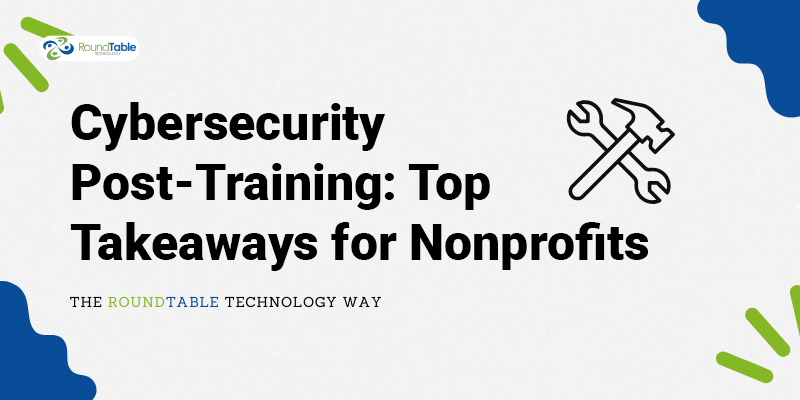Safeguarding Nonprofits: The Importance of Cybersecurity Basics
In 2023, a well-known nonprofit organization dedicated to providing clean water to underserved communities fell victim to a cyberattack. This attack...
5 min read
.jpg) Justin Brown
:
Apr 14, 2023 1:10:24 PM
Justin Brown
:
Apr 14, 2023 1:10:24 PM

As the digital landscape evolves and technology becomes increasingly intertwined with daily operations, nonprofit organizations are more vulnerable than ever to cyber threats. Cyberattacks, data breaches, and other cyber incidents can result in severe financial and reputational damages, jeopardizing the mission and operations of nonprofit organizations. To mitigate these risks, nonprofit organizations need to consider cyber liability insurance as a crucial component of their risk management strategy.
Cyber liability insurance is a specialized form of insurance coverage that is designed to protect organizations from the financial repercussions of cyber incidents. It provides coverage for the costs associated with data breaches, cyber attacks, and other cyber-related incidents, including legal fees, notification costs, credit monitoring services, public relations efforts, and regulatory fines or penalties. Cyber liability insurance is a critical safeguard that helps nonprofit organizations manage the potentially devastating financial and reputational consequences of cyber incidents.
Nonprofit organizations are not immune to cyber threats. In fact, they are often targeted by cybercriminals due to the perception that they may have weaker security measures compared to for-profit organizations. Nonprofits often collect and store sensitive data, including personally identifiable information from donors, client data, and financial records, making them prime targets for cyberattacks. Moreover, many nonprofit organizations rely heavily on technology for their day-to-day operations, such as online fundraising, email communications, and database management, increasing their exposure to cyber risks.
The costs associated with a cyber incident can quickly add up, including legal fees, forensic investigations, notification costs, credit monitoring services for affected individuals, public relations efforts to manage the reputation damage, and potential fines or penalties from regulatory agencies. These expenses can be overwhelming and may lead to severe financial strain, diverting valuable resources away from the organization's mission.
Reputational damage is also a significant concern for nonprofit organizations. A cyber incident can erode public trust and damage the organization's reputation, which may result in a loss of donor support, funding, and stakeholder confidence. Nonprofit organizations often rely on their reputation and trustworthiness to attract donors, partners, and volunteers, and a cyber incident can undermine these critical relationships.
Cyber liability insurance provides nonprofit organizations with financial protection in the event of a cyber incident, helping to cover the costs associated with responding to and recovering from a cyber attack or data breach. It offers peace of mind and an added layer of security, enabling nonprofit organizations to focus on their mission without the burden of potential financial liabilities resulting from cyber incidents.
Cyber liability insurance policies can vary depending on the insurer and policy terms, but typically, they provide coverage for several key areas related to cyber incidents. Here are some common coverages that nonprofit organizations may find in a cyber liability insurance policy:
Data Breach Response Costs: This coverage includes expenses related to managing a data breach, such as forensic investigations, legal fees, notification costs to affected individuals, and credit monitoring services.
Cyber Extortion: This coverage provides protection against cyber extortion threats, such as ransomware attacks, where cybercriminals demand payment in exchange for returning control of the organization's data or systems.
Business Interruption: This coverage compensates for the financial loss resulting from a cyber incident that disrupts the normal operations of the organization, such as revenue loss and additional expenses incurred to mitigate the impact of the incident.
Public Relations and Crisis Management: This coverage helps cover the costs of public relations efforts to manage the reputational damage resulting from a cyber incident, including communication with stakeholders, media relations, and crisis management services.
Regulatory Fines and Penalties: This coverage can help cover the costs of fines or penalties imposed by regulatory agencies in the event of a cyber incident, such as violations of data protection laws or regulations.
Cyber Liability and Legal Defense: This coverage includes legal defense costs in the event of lawsuits or legal actions resulting from a cyber incident, such as third-party claims for damages or allegations of negligence in safeguarding data.
Data Privacy and Notification: This coverage provides assistance with compliance and notification requirements in the event of a data breach, including costs associated with providing notifications to affected individuals, credit monitoring services, and legal advice on privacy regulations.
Social Engineering Fraud: This coverage protects against losses resulting from social engineering attacks, where cybercriminals manipulate employees into transferring funds or disclosing sensitive information.
It's important to note that the specific coverage and limits of a cyber liability insurance policy may vary depending on the insurer and policy terms. Nonprofit organizations should work closely with their insurance broker or agent to understand the details of their policy and ensure that it adequately addresses their unique cyber risks and exposures.
When selecting cyber liability insurance, nonprofit organizations should consider several factors to ensure they obtain the right coverage for their needs. Here are some key considerations:
Coverage Limits: Nonprofit organizations should assess their potential financial exposure in the event of a cyber incident and choose coverage limits that are adequate to cover their potential costs, including legal fees, notification expenses, credit monitoring services, and other related costs. It's important to carefully review and understand the coverage limits and sub-limits of the policy to ensure they align with the organization's risk profile and potential financial exposure.
Policy Exclusions: Nonprofit organizations should thoroughly review the policy exclusions to understand what is not covered by the policy. Common exclusions may include acts of war, intentional acts, or fraudulent activities. Understanding the policy exclusions is crucial to avoid any surprises when filing a claim.
Retroactive Coverage: Nonprofit organizations should inquire about retroactive coverage, which provides protection for incidents that may have occurred before the policy's effective date. Retroactive coverage can be critical in cases where a cyber incident may have occurred but was not discovered until after the policy was in place.
Incident Response Services: Many cyber liability insurance policies include access to incident response services, such as forensics investigations, legal counsel, and public relations support. Nonprofit organizations should assess the quality and availability of these services when evaluating cyber liability insurance options.
Risk Management Services: Some cyber liability insurance policies may offer risk management services, such as cybersecurity assessments, employee training programs, and other tools to help prevent cyber incidents. Nonprofit organizations should consider the value of these services in their risk management strategy.
Reputation Management Coverage: Reputational damage can be a significant risk for nonprofit organizations in the event of a cyber incident. Some cyber liability insurance policies may include reputation management coverage, which provides resources and support for managing the organization's reputation and public relations efforts following a cyber incident.
Claims Process and Support: Nonprofit organizations should understand the claims process and the level of support provided by the insurer in the event of a cyber incident. A smooth and efficient claims process can be crucial in the aftermath of a cyber incident, and organizations should inquire about the insurer's claims handling procedures and reputation for customer service.
In conclusion, cyber liability insurance is a critical risk management tool for nonprofit organizations in today's digital landscape. It provides financial protection against the financial and reputational damages that can result from a cyber incident, including data breaches, ransomware attacks, and other cyber threats.
Nonprofit organizations should carefully assess their unique cyber risks, review and compare different cyber liability insurance policies, and work closely with their insurance broker or agent to ensure they have the right coverage in place. In combination with strong cybersecurity measures and a well-prepared incident response plan, cyber liability insurance can help nonprofit organizations safeguard their mission, operations, and stakeholders in the face of growing cyber threats.
If you would like to speak to one of our Cybersecurity Experts about your current cybersecurity controls or if you have enough coverage in your policy, you can schedule a free Cyber Liability Gap Analysis here.
We will take a close look at your current policy, if you have one, and have partnerships with insurers that can make sure your organization is protected.

In 2023, a well-known nonprofit organization dedicated to providing clean water to underserved communities fell victim to a cyberattack. This attack...

Nonprofit organizations have a responsibility to protect their donors' information, as well as their own. This means that cybersecurity awareness...

In our increasingly digital world, cybersecurity is not just a buzzword but a critical foundation of any organization's operational integrity. This...